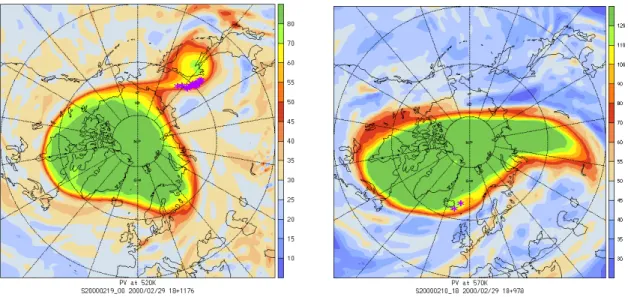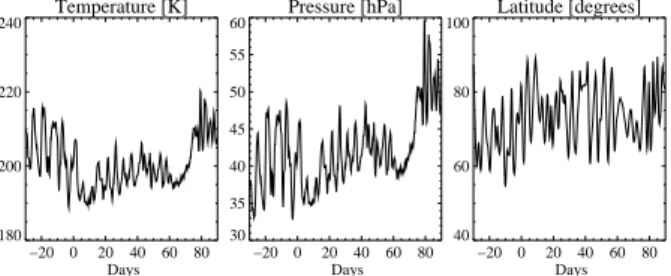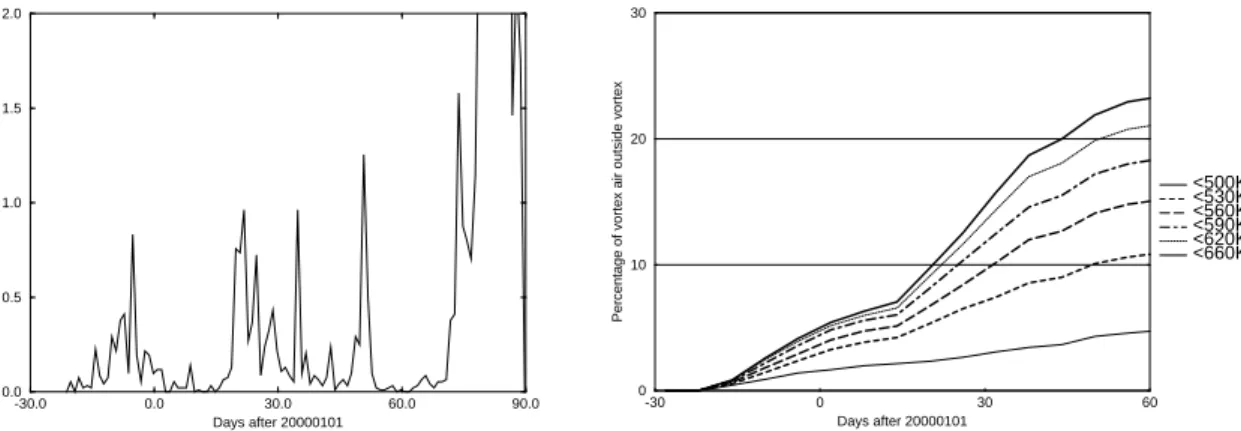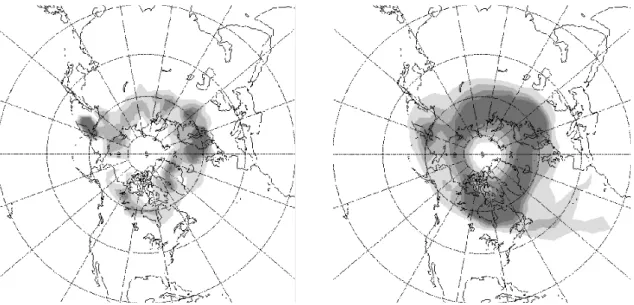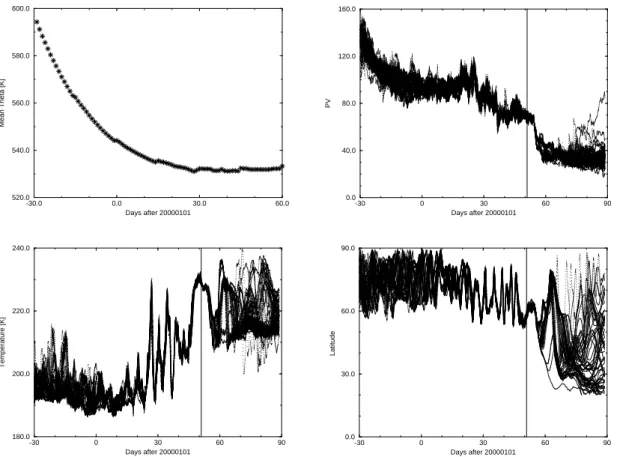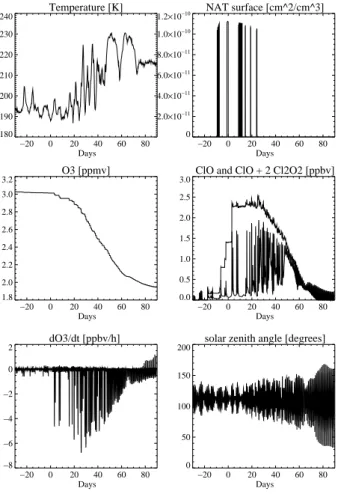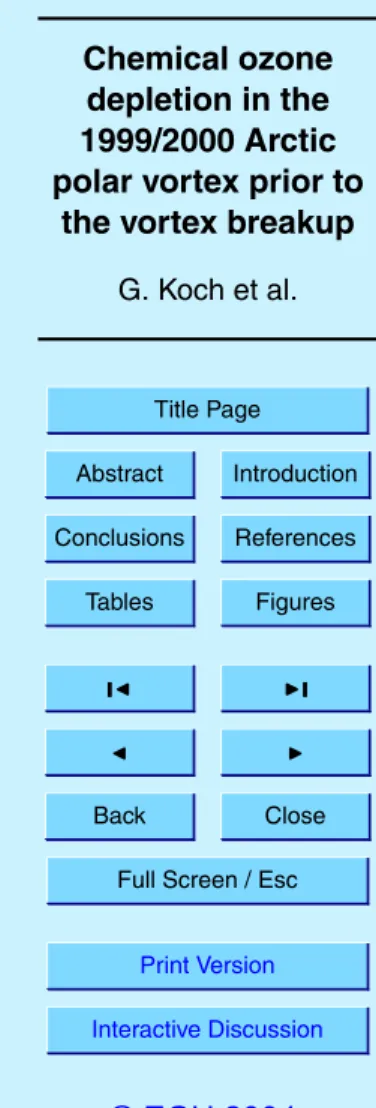HAL Id: hal-00301175
https://hal.archives-ouvertes.fr/hal-00301175
Submitted on 5 Apr 2004HAL is a multi-disciplinary open access
archive for the deposit and dissemination of sci-entific research documents, whether they are pub-lished or not. The documents may come from teaching and research institutions in France or abroad, or from public or private research centers.
L’archive ouverte pluridisciplinaire HAL, est destinée au dépôt et à la diffusion de documents scientifiques de niveau recherche, publiés ou non, émanant des établissements d’enseignement et de recherche français ou étrangers, des laboratoires publics ou privés.
Quantification of the impact in mid-latitudes of chemical
ozone depletion in the 1999/2000 Arctic polar vortex
prior to the vortex breakup
G. Koch, H. Wernli, S. Buss, J. Staehelin, T. Peter, M. A. Liniger, S. Meilinger
To cite this version:
G. Koch, H. Wernli, S. Buss, J. Staehelin, T. Peter, et al.. Quantification of the impact in mid-latitudes of chemical ozone depletion in the 1999/2000 Arctic polar vortex prior to the vortex breakup. Atmospheric Chemistry and Physics Discussions, European Geosciences Union, 2004, 4 (2), pp.1911-1940. �hal-00301175�
ACPD
4, 1911–1940, 2004Chemical ozone depletion in the 1999/2000 Arctic polar vortex prior to
the vortex breakup
G. Koch et al. Title Page Abstract Introduction Conclusions References Tables Figures J I J I Back Close
Full Screen / Esc
Print Version Interactive Discussion
Atmos. Chem. Phys. Discuss., 4, 1911–1940, 2004 www.atmos-chem-phys.org/acpd/4/1911/
SRef-ID: 1680-7375/acpd/2004-4-1911 © European Geosciences Union 2004
Atmospheric Chemistry and Physics Discussions
Quantification of the impact in
mid-latitudes of chemical ozone depletion
in the 1999/2000 Arctic polar vortex prior
to the vortex breakup
G. Koch1, H. Wernli1, S. Buss1, J. Staehelin1, T. Peter1, M. A. Liniger2, and S. Meilinger3
1
IACETH, ETH Zurich, Switzerland
2
MeteoSwiss, Zurich, Switzerland
3
Max-Planck Institute for Chemistry, Mainz, Germany
Received: 24 February 2004 – Accepted: 19 March 2004 – Published: 5 April 2004 Correspondence to: Gisela Koch (gisela.koch@env.ethz.ch)
ACPD
4, 1911–1940, 2004Chemical ozone depletion in the 1999/2000 Arctic polar vortex prior to
the vortex breakup
G. Koch et al. Title Page Abstract Introduction Conclusions References Tables Figures J I J I Back Close
Full Screen / Esc
Print Version Interactive Discussion
Abstract
For the winter 1999/2000 transport of air masses out of the vortex to mid-latitudes and ozone destruction inside and outside the northern polar vortex is studied to quantify the impact of earlier winter (before March) polar ozone destruction on mid-latitude ozone.
Nearly 112 000 trajectories are started on 1 December 1999 on 6 different potential
5
temperature levels between 500–600 K and for a subset of these trajectories photo-chemical box-model calculations are performed. We linked a decline of −0.9% of mid-latitude ozone in this layer occurring in January and February 2000 to ozone destruc-tion inside the vortex and successive transport of these air masses to mid-latitudes.
Further, the impact of denitrification, PSC-occurrence and anthropogenic chlorine
10
loading on future stratospheric ozone is determined by applying various scenarios. Lower stratospheric temperatures and denitrification were found to play the most im-portant role in the future evolution of polar ozone depletion.
1. Introduction
While our understanding of processes leading to ozone destruction inside the polar
15
vortices has improved continuously over the recent years, estimates of its impact on the mid-latitude ozone layer remain uncertain (WMO, 2002).
Various processes are conceivable: (i) Transport of ozone depleted vortex air masses to lower latitudes, (this is expected to take place mainly in spring, when sun-light reaches higher latitudes and the vortex breaks up (e.g. Knudsen and Grooss,
20
2000), and (ii) transport of chlorine activated air to lower latitudes with subsequent ozone destruction in the mid-latitudes (this can take place already in the earlier win-ter when PSC-activated air reaches lower latitudes and therewith sunlight). Vortex air masses can reach mid-latitudes either by reversible excursions of the vortex (James et al., 2000) or irreversible transport across the vortex edge. This latter process
oc-25
ACPD
4, 1911–1940, 2004Chemical ozone depletion in the 1999/2000 Arctic polar vortex prior to
the vortex breakup
G. Koch et al. Title Page Abstract Introduction Conclusions References Tables Figures J I J I Back Close
Full Screen / Esc
Print Version Interactive Discussion
air. Reid et al. (1998) studied ozone laminae in the lower stratosphere that usually appear as soon as the vortex has formed and reach maximum abundances in late win-ter and spring. For the winwin-ter 1994/95, using a photochemical trajectory model, they showed that ozone concentrations inside laminae fall progressively with time and mix irreversibly with mid-latitude air.
5
Norton and Chipperfield (1995) quantified the transport of chemically activated air from the polar vortex to mid-latitudes using a 3-D off-line chemical transport model for the winters 1991/1992, 1992/1993 and 1993/1994. Their calculations indicate con-siderable interannual variation in the amount of PSC-activated air transported to mid-latitudes in January and February in the respective years, ranging between 10 and 50%
10
of the total vortex air mass. They concluded that in situ destruction of ozone in mid-latitudes by activated air masses from inside the vortex contributes to observed ozone decrease in mid-latitudes, but also assume in situ processes involving sulfate aerosols to be important. Hadjinicolaou et al. (2002) found similar results by CTM modeling using a highly parameterized chemical scheme.
15
The high-resolution advection model MIMOSA was used by Hauchecorne et al. (2002) to quantify air masses transported from the vortex to mid-latitudes for the four winters 1996/1997 to 1999/2000. They found that during periods with a very cold and isolated vortex, like from January to March 2000, the transport of ozone-depleted air from the vortex (defined in their study as the region with equivalent latitude >65◦N)
20
to mid-latitudes (equivalent latitude between 30◦–60◦N) in filaments plays a minor role in the observed decline of mid-latitude ozone.
However, Godin et al. (2002) found vortex excursions to be able to penetrate as far as Haute-Provence Observatory (44◦N, 5.7◦E) from January to March 2000 and could ascribe an ozone reduction by 1.6% in the 400–650 K potential temperature range to
25
such excursions using a chemical transport model.
Knudsen and Andersen (2001) calculated longitudinal variations in springtime ozone trends by using satellite data for the time period 1979–1997. With a multiple linear-regression model they attributed 19% of the observed ozone trends on average at
ACPD
4, 1911–1940, 2004Chemical ozone depletion in the 1999/2000 Arctic polar vortex prior to
the vortex breakup
G. Koch et al. Title Page Abstract Introduction Conclusions References Tables Figures J I J I Back Close
Full Screen / Esc
Print Version Interactive Discussion
mid-latitude (30–60◦N) to vortex depletion.
In this study we quantify the in-out exchanges for the northern polar vortex in the winter 1999/2000 with a comprehensive trajectory analysis and focus on transport out of the vortex in January and February when the vortex is stable. This has been mo-tivated by the fact that at mid-latitudes negative ozone trends have been observed in
5
the earlier winter: e.g. at Payerne, Switzerland, ozone concentrations at 50 hPa have decreased in January by −5.4%/decade and in February by −4.6%/decade for the pe-riod 1970–2001 (Koch et al., 2002). This compares with −1.8%/decade determined from the annual averages, highlighting the importance of the winter time. As shown in Koch et al. (2002) (Fig. 8c), these changes cannot simply be ascribed to changes in
10
dynamics. With photo-chemical box model calculations along selected trajectories we quantify the ozone destruction inside and outside the vortex to determine the contribu-tion of polar ozone destruccontribu-tion on mid-latitude ozone. Further, the impact of denitrifica-tion, PSC-occurrence and anthropogenic chlorine loading on future evolvement of the ozone shield is determined by applying various scenarios.
15
2. Data and method
2.1. Trajectory analysis
For the winter SOLVE/THESEO 1999/2000 111936 4-months forward trajectories were calculated. These trajectories were started at 1 December 1999 00 UTC, north of 55◦N on a grid with horizontal distance of 50 km on 6 potential temperature levels in
20
the lower/middle stratosphere (500, 530, 560, 590, 620 and 660 K). For this study high-resolution ECMWF (T319L60) wind and temperature fields were used. These data are available every 6 h with an average distance between grid points close to 62 km. We used isentropic trajectories, but included diabatic sinking constructed from two N2O profiles measured during the SOLVE/THESEO campaign by ASUR (see Kleinb ¨ohl et
25
ACPD
4, 1911–1940, 2004Chemical ozone depletion in the 1999/2000 Arctic polar vortex prior to
the vortex breakup
G. Koch et al. Title Page Abstract Introduction Conclusions References Tables Figures J I J I Back Close
Full Screen / Esc
Print Version Interactive Discussion
M ¨uller (1994). Trajectories starting on 590 K in December reach potential temperatures of about 530 K in January.
To characterize exchange events of air inside and outside of the vortex we use the the strongest PV-gradient found on the respective potential temperature level to define the vortex edge and denote this (time-dependent) PV value as PV∗. For this purpose
5
the PV gradients were fitted to a Gaussian curve in order to avoid multiple maxima and displayed as a function of equivalent latitude. As a side criterion the wind speed of this equivalent latitude should be a substantial fraction of the wind maxima. All trajectories were checked for their exchange time, which is the last time a trajectory crosses the vortex edge from inside to outside (i.e. PV falls definitively below PV∗). As also outside
10
to inside exchanges are considered, an air parcel is regarded to be inside the vortex if PV≥PV∗for at least 4 successive days in order to avoid transient “exchanges” (possibly affected by inaccuracies in the calculation of the potential vorticity).
Exchange events are characterized by decreases in the potential vorticity of an air parcel. In this winter (1999/2000) there is one major case in February when a part
15
of the vortex splits off. This event is shown in Fig. 1 (top panel): the color indicates the potential vorticity on the 520 K level. The vortex edge at that time is at 62 pvu and the stars indicate the locations where air parcels leave the vortex. During the days following this split-off event the separated part dissolves in extra-vortex air and each air parcel inside this blob of air undergoes an exchange event characterized by a drop
20
in PV. On the bottom panel the situation is different: in this case only single air parcels leave the vortex. Finally, by the end of March, all air parcels are regarded to be outside the vortex, i.e. the vortex has broken up irreversibly.
In a second step, box model calculations were performed for 1000 4-months forward trajectories leaving the vortex in January or February 2000.
25
2.2. Photo-chemical box model
The development and early applications of the Mainz photo-chemical box model can be found in Crutzen et al. (1992) and M ¨uller et al. (1994). The model calculates the
ACPD
4, 1911–1940, 2004Chemical ozone depletion in the 1999/2000 Arctic polar vortex prior to
the vortex breakup
G. Koch et al. Title Page Abstract Introduction Conclusions References Tables Figures J I J I Back Close
Full Screen / Esc
Print Version Interactive Discussion
temporal evolution of the most important chemical species in a “box” moving along a given trajectory by integrating a set of differential equations describing the chemical reactions by means of the FACSIMILE software (Curtis and Sweetenham, 1987), which uses an implicit integration scheme for stiff differential equations (Gear, 1971). The kinetic reaction rates are taken from DeMore et al. (1997), Atkinson et al. (1999) and
5
Brown et al. (1999a,b).
The model version used for this study includes 57 chemical species with 126 gas-phase (110 bimolecular and 16 termolecular) and 31 photolysis reactions. The addi-tional heterogeneous reactions on surfaces or on/in liquid aerosols implemented in the box-model are described in Table1.
10
For the initialization of this model we used data from balloon measurements with the MkIV Interferometer on 3 December 1999 at Esrange (Sweden) for the initial concen-trations of 21 species (O3, HNO3, H2O, CH4, H2, HCHO, HCl, ClO, H2O2, HO2NO2,
NO, NO2, NO3, N2O5, CO, HBr, BrO, BrONO2, OClO).
The ozone profile determining the amount of ozone above the considered box und
15
thus the amount of UV available for photolysis reactions is taken from the 2-dimensional ozone climatology by Fortuin and Kelder (1998). Denitrification was also taken into account in our calculation by adding a denitrification “loss term” that reduces HNO3 linearly in time by 50% for all potential temperature levels considered (500–660 K). This is based on in situ measurements that suggested an average removal of 60% of
20
the reactive nitrogen reservoir NOy between 16 and 21 km in that winter (Popp et al., 2001).
An example of the temporal evolution of different physical and chemical parameters along a trajectory starting near the North Pole on 530 K on 1 December 1999 is shown in Fig.2. This trajectory stays within the vortex close to its edge throughout the whole
25
winter and does not reach latitudes less than 60◦N in January to March. At the end of December 1999 and in January 2000 temperatures reach very low levels (below 190 K). In the model NAT (≡HNO3·3H2O) particles with a number density of 1 cm−3 are initialized if the saturation ratio of NAT SNAT reaches 10 (this corresponds to a
ACPD
4, 1911–1940, 2004Chemical ozone depletion in the 1999/2000 Arctic polar vortex prior to
the vortex breakup
G. Koch et al. Title Page Abstract Introduction Conclusions References Tables Figures J I J I Back Close
Full Screen / Esc
Print Version Interactive Discussion
temperature of about 3 K below TNAT). Once formed, NAT particles are treated as being in equilibrium with the gas phase. The volume of NAT is calculated from the difference between the total HNO3partial pressure and the HNO3 vapor pressure of NAT (Vapor pressures of Hanson and Mauersberger, 1988 are used). The condensed mass is then distributed evenly between the number of particles assumed to nucleate in order
5
to calculate the particle radius and surface area (a monodisperse treatment). In the late winter the solar zenith angle often drops below 90◦and Cl2O2is readily photolyzed to ClO, leading to enhanced ozone destruction. For this particular trajectory the initial 3.2 ppmv of ozone are reduced by 25% by the end of March with an ozone destruction rate of up to 6 ppbv/h.
10
3. Overview of the exchange events
The SOLVE/THESEO winter 1999/2000 was an unusually cold winter with a strong vortex lasting throughout the whole winter (Manney, 2000). In general, the isolation of the polar vortex is a key ingredient to polar ozone loss, since the vortex region evolves without being disturbed too much. Vortex disturbances can occur due to enhanced
15
wave activity, which leads to an increase in mixing processes of air masses inside and outside the vortex or even to a break-up of the vortex during the winter. If the vortex is stable, the strong polar night jet keeps out intrusions of warmer, and on certain levels also ozone-rich and NOx-rich air from mid-latitudes.
In this chapter we focus on trajectories leaving the vortex in January and February,
20
where no transient (or even permanent) break-up occurred. Nevertheless some trajec-tories did leave the vortex in the early winter and thus contributed directly or indirectly to midlatitude ozone loss.
From the ensemble of all 111 936 trajectories started on 1 December north of 50◦N about 90% have been inside the vortex for time periods between some days up to 4
25
ACPD
4, 1911–1940, 2004Chemical ozone depletion in the 1999/2000 Arctic polar vortex prior to
the vortex breakup
G. Koch et al. Title Page Abstract Introduction Conclusions References Tables Figures J I J I Back Close
Full Screen / Esc
Print Version Interactive Discussion
3.1. Temporal distribution of exchanges
Mixing events across the polar vortex edge do not occur evenly distributed in time. Figure3shows the temporal evolution of the amount of vortex air having left the vortex definitively.
The major amount leaves the vortex at the end of March, but there is a significant
5
number of trajectories making an in-out exchange earlier in the winter. These ex-changes are more frequent on lower potential temperature levels (below 530 K) than on higher levels (up to 660 K), which is due to the less stable structure of the vortex at lower altitudes. For the winter 1999/2000 about 24% of the vortex air between 480 and 660 K leaves the vortex before March. These air masses are by then already reduced
10
in ozone and/or chemically activated. The total of this intruding air mass corresponds to about 11% of the air residing at mid-latitudes, i.e. represents a significant fraction. 3.2. Spatial distribution of exchanges
Similarly to the temporal distribution of the exchanges occurring in mid-winter (January and February), also the spatial structure of the exchange events shows preferred
re-15
gions. Besides the maximum in Fig.4(top) between 140–160◦E and 50–60◦N close to the Aleutians high (which will be focussed on in the next section), another pronounced maximum is found west of and over Scandinavia. Most of the trajectories leaving the vortex at these locations stay close to the vortex edge and do not immediately spread out into lower latitudes. The bottom panel in Fig.4shows that this is true for most of the
20
trajectories. They stay in the vicinity of the vortex edge at least in the 10 days following the exchange where they reside in the latitude band between 50 and 70◦N. Only a few trajectories reach much lower latitudes within the 10 days following the exchange (light grey area in Fig.4, right, between 20 and 60◦W and south of 50◦N).
ACPD
4, 1911–1940, 2004Chemical ozone depletion in the 1999/2000 Arctic polar vortex prior to
the vortex breakup
G. Koch et al. Title Page Abstract Introduction Conclusions References Tables Figures J I J I Back Close
Full Screen / Esc
Print Version Interactive Discussion
4. Split off event in late February 2000
A closer look at the temporal evolution of the cross vortex-edge exchanges of the tra-jectories that started on 590 K (Fig. 3, top) and left the vortex before March reveals that there are pronounced single events superimposed on a background level of less substantial peeling-off of about 0.25% of vortex air per day. The most pronounced
5
event around 20 February 2000 corresponds to the case shown in Fig. 1 on the top panel. The amount vortex air that leaves the vortex on this single event corresponds to about 1% of all mid-latitude air (between 460 and 660 K and between 30◦N and the vortex edge), in which it is mixed irreversibly. This event is most pronounced in the lower stratosphere (460 K), becomes less important on higher isentropes and can not
10
be observed on altitudes higher than 600 K.
This event can also be seen in the spatial distribution of in-out-exchanges in Fig.5. The maximum between 140–160◦E and 50–60◦N corresponds to the event of the max-imum in Fig.3 (top) around day 51. In the following we will focus on the 65 trajecto-ries that started on 590 K inside the vortex and leave the vortex on 20 February 2000
15
12 UTC on about 530 K between 140–160◦E and 50–60◦N. These 65 trajectories have already descended to approx. 530 K before their encounter with the exchange event, during which they leave the vortex definitively and are then dispersed soon after the exchange throughout the mid-latitudes.
During this event the potential vorticity along the trajectories decreases from about
20
70-80 pvu on 14 February to less than 55 pvu on 26 February (Fig.6). The trajectories cross the vortex edge (stars in Fig. 6) on 20 February and PV is strongly reduced around 24 February.
All trajectories have been inside the vortex for the whole time period between 1 De-cember 1999 and 20 February 2000 (see high PV values in Fig.7, top) and have all
25
undergone temperatures below NAT existence temperature, between late December and late January (Fig.7, middle). From end of January the trajectories stay close to-gether until the exchange. Once outside the vortex the trajectories disperse within two
ACPD
4, 1911–1940, 2004Chemical ozone depletion in the 1999/2000 Arctic polar vortex prior to
the vortex breakup
G. Koch et al. Title Page Abstract Introduction Conclusions References Tables Figures J I J I Back Close
Full Screen / Esc
Print Version Interactive Discussion
weeks and their latitudes range between 20 and 90◦N (Fig.7, bottom).
For these 65 trajectories box-model calculations were performed. Figure8shows the evolution of ozone and other parameters along one of these 65 trajectories: the very cold temperatures in the first third of January lead to chlorine activation with ClO con-centrations of up to 2 ppbv, which are proportional to the ozone production/destruction
5
rate. Maximum values of −7 ppbv/h are reached in the second half of January. In-side the vortex 0.8 ppmv ozone are destroyed, which is about one quarter of the ozone starting value. In the time period after the exchange event another 0.25 ppmv of ozone are depleted.
The evolution of all 65 trajectories leaving the vortex on 20 February 2000 took a
10
course similar to this selected one. The maximum ozone destruction is 1.2 ppmv during the 4 months, the minimal destruction 0.8 ppmv, the average is 0.94 ppmv (Fig. 9). This means that inside the vortex about 25% of the initial ozone is destroyed, and outside another 0.3 ppmv (6%). Note that possible mixing processes at mid-latitudes are not included in the model. Mixing can be expected to further reduce the in any case
15
small out-of-vortex destruction of 6%, as chlorine deactivation may occur and slow the halogen-driven destruction cycles. The total amount of air leaving the vortex at this specific event on 20 February 2000 corresponds to about 1% of mid-latitude air. This contributes to an overall mid-latitude decrease of −0.25% in ozone at 530 K due to this event.
20
Besides denitrification, the other crucial factor for ozone depletion and its future evo-lution is the chlorine loading in the stratosphere, which is expected to start decreasing around the year 2000. Chlorine concentrations of the 2-D climatology of Grooss et al. (1998) for the year 1980 leads to reductions of about 50% of chlorine in the strato-sphere. The modeled ozone destruction of one quarter (without denitrification) and one
25
third (with denitrification) decreases to 13% and 15%, respectively. This means that un-der present meteorological conditions ozone depletion for the trajectories consiun-dered here would be reduced by a factor of 2 assuming 1980s chlorine concentrations.
ACPD
4, 1911–1940, 2004Chemical ozone depletion in the 1999/2000 Arctic polar vortex prior to
the vortex breakup
G. Koch et al. Title Page Abstract Introduction Conclusions References Tables Figures J I J I Back Close
Full Screen / Esc
Print Version Interactive Discussion
5. Impact of polar ozone depletion on mid-latitudes
Box-model calculations were performed for nearly 900 trajectories, which have been selected using the criterion that they leave the vortex already in January or February. 5.1. Ozone destruction inside the vortex
Ozone destruction along these trajectories varies (depending mainly on the time they
5
stayed inside the vortex) between −5 and −50%. By the end of February, on the aver-age −28% of initial ozone is chemically destroyed inside the vortex (see Fig.10, note that only ozone destruction occurring inside the vortex is averaged). Air masses leav-ing the vortex at the end of January carry on average −8% reduced ozone amounts. Note that the standard deviation increases with time due to the fact that the number of
10
trajectories contributing to the mean value decreases with time. At the end of February 2000 about 11% of the mid-latitude air mass has been inside the vortex. This means that before March a decrease of −0.9% of mid-latitude ozone in the layer between 500 and 660 K can be ascribed to ozone destruction inside the vortex and subsequent transport of these air masses to mid-latitudes.
15
5.2. Heterogeneous chemistry
Considering homogeneous processes alone, lower air temperatures lead to reduced ozone destruction because of the temperature dependence of the catalytic ozone de-struction cycles. However, heterogeneous reactions play a key role in polar ozone chemistry, without which presently observed ozone loss rates could not be explained.
20
The temperature when particles hosting heterogeneous chemical reactions, such as NAT (Nitric Acid Trihydrate) on STS (supercooled ternary solution droplets) can form depends on the amount of H2O and HNO3 in the atmosphere. Under lower strato-spheric conditions NAT equilibrium is reached at temperatures between 190 and 195 K. The average ozone loss for trajectories starting between 530 and 620 K mainly
ACPD
4, 1911–1940, 2004Chemical ozone depletion in the 1999/2000 Arctic polar vortex prior to
the vortex breakup
G. Koch et al. Title Page Abstract Introduction Conclusions References Tables Figures J I J I Back Close
Full Screen / Esc
Print Version Interactive Discussion
pends on whether – and if so for how long – the respective air mass experienced temperatures below NAT existence temperature (TNAT). If ozone destruction depended only on homogeneous reactions, only about 10% of December ozone mixing ratios are depleted during the winter. Figure 11 (top) shows that, the longer the trajectory stays under very cold conditions, the more ozone is depleted up to a maximum value
5
of about 1 ppmv (about 30%), which is reached already within time periods below TNAT of 15 h (not necessarily in direct succession). This maximum depletion does not de-crease to much lower values, even when the time below TNAT increases up to 100 h and more (Fig.11, bottom), but obviously reaches its saturation (i.e. all ClONO2 has been converted to active chlorine).
10
5.3. Denitrification
Future ozone losses over the Arctic are difficult to predict because of the uncertainty about future trends in stratospheric temperature. In the stratosphere increased con-centrations of greenhouse gases cause greater radiative cooling and hence lower tem-peratures (Austin and Butchardt, 1992), which lead to more effective chlorine activation
15
via heterogeneous reactions. Langematz et al. (2003) found winter temperature trends at 100 hPa of up to −4 K/decade for the time period 1979–2000 using FUB data and NCEP/NCAR reanalyses. This potential cooling may cause severe Arctic ozone losses even when chlorine levels are decreasing.
The most important process to remove NOx(which is mainly tied up as HNO3) is the
20
formation of NAT and ice at very low temperatures (about less than 190 K). Sedimenta-tion of PSC particles leads to a vertical redistribuSedimenta-tion of the reactive nitrogen reservoir (NOy). While the important role of denitrification for the formation of the Antarctic ozone hole was knows since a long time, Waibel et al. (1999) were the first to show that den-itrification also occurs in the Arctic polar stratosphere. Fot the winter 1999/2000, a
25
reduction of more than 10 ppbv at 21 km (denitrification) as well as an increase in NOy below 15 km (nitrification) has been reported by Popp et al. (2001). This denotes a removal of more than 60% of NOy on altitudes between 16 and 21 km (with a
maxi-ACPD
4, 1911–1940, 2004Chemical ozone depletion in the 1999/2000 Arctic polar vortex prior to
the vortex breakup
G. Koch et al. Title Page Abstract Introduction Conclusions References Tables Figures J I J I Back Close
Full Screen / Esc
Print Version Interactive Discussion
mum at 21 km). For this study HNO3was reduced by about 50% linearly in time for all potential temperature levels considered (500–660 K). The consequences of denitrifica-tion on ozone depledenitrifica-tion is shown in Fig.12. Box-model calculations indicate that ozone destruction along trajectories starting on 590 K decreases by approx one third until the end of the winter when denitrification is not considered.
5
5.4. Chlorine loading
In 1987, 27 nations signed the Montreal Protocol and agreed to a 50% reduction in CFC production by 1999. Soon after, new scientific evidence indicated that this action would not be sufficient to stop the destruction of the ozone layer. This lead to the Copenhagen Amendment of 1992, where the complete phase-out of CFCs by 1996
10
was decided. As a result a turnaround in stratospheric chlorine trends is expected to take place around the year 2000. Figure12shows that (besides denitrification) chlorine loading in the stratosphere is the crucial point for present and future ozone loss. Under present (year 2000 chlorine loading and denitrification) conditions the average ozone loss until end of February along trajectories starting on 590 K and leaving the vortex in
15
January or February is about −18%. A reduction of 50% of chlorine in the stratosphere, which corresponds to 1980’s values, leads to a reduction of ozone depletion by a factor of more than two.
6. Conclusions
Ozone decline at mid-latitudes in the earlier winter is likely to be influenced by Arctic
20
ozone depletion. This impact has been quantified for the winter 1999/2000, which is characterized by a strong well-isolated vortex with very low temperatures. About one quarter of in-vortex air leaves the vortex before March. Within these air masses ozone is reduced by up to −28% (depending on the time inside the vortex). We linked a decline of −0.9% of mid-latitude ozone occurring before March to ozone destruction
ACPD
4, 1911–1940, 2004Chemical ozone depletion in the 1999/2000 Arctic polar vortex prior to
the vortex breakup
G. Koch et al. Title Page Abstract Introduction Conclusions References Tables Figures J I J I Back Close
Full Screen / Esc
Print Version Interactive Discussion
inside the vortex and successive transport of these air masses to mid-latitudes. Of course, vortex evolution and temperatures are highly variable from year to year and these results cannot simply be applied to other winters. In a warmer winter with a less stable vortex in-out exchanges during the winter are more likely, but on the other hand with less PSC-occurrence less ozone depletion is expected for
5
each individual event. In the winter 1999/2000 an extensive measurement campaign (SOLVE/THESEO-2000) was performed that allowed reliable assumptions concerning e.g. denitrification and comparison with observed ozone depletion. POAM III observa-tions (Hoppel et al., 2002) suggested maximum ozone loss (1 January to 15 March) of 1.8 ppmv at 500 K, which is in the same order of magnitude as Match results (Rex et
10
al., 2002). Ozone depletion in this study is about half of these values, but is averaged only over trajectories that leave the vortex in January or February and thus may expe-rience colder temperatures only for a shorter time. Ozone loss rates from Match (with maxima of 6 ppbv per sunlit hour in the earlier winter) are similar to those obtained in this analysis.
15
We found that about one quarter of vortex air between 480 and 660 K leaves the vor-tex before March, when the vorvor-tex eventually breaks up. This is substantially more than has been found by Hauchecorne et al. (2002) who found only about 5% for this winter. The main difference between these studies is the definition of the vortex. Whereas Hauchecorne et al. (2002) used equivalent latitudes >65◦N for an inside-vortex
cri-20
terion and defined the vortex edge (60–65◦) separately, we used a time-dependent (6 h-resolution) vortex definition according to the strongest PV gradient. Additionally, in our study December is included, when already 5% of vortex air already left the vortex. The large amount of nearly 112 000 4-months trajectories and the comprehensive subset of about 1000 trajectories on which box-model calculations were performed,
25
provided clear evidence that heterogeneous ozone depletion in the polar vortex and the subsequent transport of ozone depleted air masses before the break-down of the polar vortex (e.g. for January and February) significantly influences ozone in mid-latitudes.
ACPD
4, 1911–1940, 2004Chemical ozone depletion in the 1999/2000 Arctic polar vortex prior to
the vortex breakup
G. Koch et al. Title Page Abstract Introduction Conclusions References Tables Figures J I J I Back Close
Full Screen / Esc
Print Version Interactive Discussion
significant role in polar ozone depletion. Lower stratospheric temperatures and deni-trification play the most important role in the future evolution of polar ozone depletion when ODS are expected to have decreased significantly due to the successful imple-mentation of the Montreal Protocol and its amendments.
References 5
Austin, J. and Butchart, N.: A 3-dimensional modeling study of the influence of planetary wave dynamics on polar ozone photochemistry, J. Geophys. Res., 97, 10 165–10 186, 1992. Atkinson, R., Baulch, D. L., Cox, R. A. et al.: Summary of evaluated kinetic and photochemical
data for atmospheric chemistry,http://www.iupac-kinetic.ch.cam.ac.uk/, 1999.
Brown, S. S., Talukdar, R. K., and Ravishankar, A. R.: Reconsideration for the reaction of
10
hydroxyl radicals with nitric acid, J. Phys. Chem., A103, 3031–3037, 1999a.
Brown, S. S., Talukdar, R. K., and Ravishankar, A. R.: Rate constant for the reaction OH+ NO2
+ M → HNO3+ M under atmospheric conditions, Chem. Phys. Lett., 299, 277–284, 1999b.
Crutzen, P. J., M ¨uller, R., Br ¨uhl, C., and Peter, T.: On the potential importance of the gas-phase CH3O2+ CLO → CLOO + CH3O and the heterogeneous reaction HOCL + HCL → H2O+
15
CL2in ozone hole chemistry, Geophys. Res. Lett., 19, 1113–1116, 1992.
Curtis, A. R. and Sweetenham, W.P.: Facsimile/Chekmat User’s Manual, Comp. Sci. and Syst. Div. Harvell Lab., Oxford, UK, 1987.
DeMoore, W. B., Sander, S. P.; Golden, D. M. et al.: Chemical kinetics and photochemical data for use in stratospheric modeling, JPL Publications, 97-4, 269, Pasadena, 1997.
20
Fortuin, J. P. F. and Kelder, H.: An ozone climatology based on ozonesonde and satellite mea-surements, J. Geophys. Res., 103, 31 709–31 734, 1998.
Gear, C.W.: The automatic integration for ordinary differential equations, Numer. Math., 14, 176–179, 1971.
Godin, S., Marchand, M., Hauchecorne, A., and Lef `evre, F.: Influence of Arctic polar ozone
25
depletion on lower stratospheric ozone amounts at Haute-Provence Observatory (43.92◦N, 5.71◦E), J. Geophys. Res., 107, 8272, doi:10.1029/2001JD000516, 2002.
Grooss, J.-U., Bruehl, C., and Peter, T.: Impact of aircraft emissions on tropospheric and strato-spheric ozone, Part I: Chemistry an 2D-model results, Atmos. Environ., 32, 3173–3184, 1998.
ACPD
4, 1911–1940, 2004Chemical ozone depletion in the 1999/2000 Arctic polar vortex prior to
the vortex breakup
G. Koch et al. Title Page Abstract Introduction Conclusions References Tables Figures J I J I Back Close
Full Screen / Esc
Print Version Interactive Discussion
Hadjinicolaou, P., Jrrar, A., Pyle, J.A., and Bishop, L.: The dynamically driven long-term trend in stratospheric ozone over northern middle latitudes, Q. J. R. Meteorol. Soc., 128, Part A, 1393–1412, 2002.
Hanson, D. and Mauersberger, K.: Laboratory studies of the nitric acid trihydrate – implications for the south polar stratosphere, Geophys. Res. Lett., 15, 855–858, 1988.
5
Hauchecorne, A., Godin, S., Marchand, M., Heese, B., and Souprayen, C.: Quantification of the transport of chemical constituents from the polar vortex to midlatitudes in the lower stratosphere using the high-resolution advection model MIMOSA and effective diffusivity, J. Geophys. Res., 107, 8289, doi:10.1029/2001JD000491, 2002.
Hoppel, K., Bevilacqua, R., Nedoluha, G., Daniel, C., Lef `evre, F., Lumpe, J., Fromm, M.,
Ran-10
dall, C., Rosefield, J., and Rex, M.: POAM III observations of arctic ozone loss for the 1999/2000 winter, J. Geophys. Res., 107, 8262, doi:10.1029/2001JD000476, 2002.
James, P. M., Peters, D., and Waugh, D. W.: Very low ozone episodes due to polar vortex displacement, TELLUS SERIES B, 52, 1123–1137, 2000.
Knudsen, B. M. and Andersen, S. B.: Geophysics – Longitudinal variation in springtime ozone
15
trends, NATURE, 413, 699–700, 2001.
Knudsen, B. M. and Grooss, J. U.: Northern midlatitude stratospheric ozone dilution in spring modeled with simulated mixing, J. Geophys. Res., 105, 6885–6890, 2000.
Kleinb ¨ohl, A., Bremer, H., von Koenig, M. et al.: Vortex-wide denitrification of the Arctic polar stratosphere in winter 1999/2000 determined by remote observation J. Geophys. Res., 108,
20
8305, doi:10.1029/2001JD001041, 2003.
Koch, G., Wernli, H., Staehelin, J., and Peter, Th.: A Lagrangian analysis of stratospheric ozone variability and long-term trends above Payerne (Switzerland) during 1970–2001, J. Geophys. Res., 107, 4373, doi:10.1029/2001JD001550, 2002.
Langematz, U., Kunze, M., Kr ¨uger, K., Labitzke, K., and Roff, G. L.: Thermal and
dynami-25
cal changes of the stratosphere since 1979 and their link to ozone and CO2 changes, J. Geophys. Res., 108, 4027, doi:10.1029/2002JD002069, 2003.
Manney, G. L. and Sabutis, J. L.: Development of the polar vortex in the 1999–2000 Arctic winter stratosphere, Geophys. Res. Lett., 27, 2589–2592, 2000.
Manney, G. L., Sabutis, J. L., and Swinbank, R.: A unique stratospheric warming event in
30
November 2000, Geophys. Res. Lett., 28, 2629–2632, 2001.
M ¨uller, R.: Die Chemie des Ozons in der polaren Stratosph ¨are, Dissertation, Shaker Verlag, Achen, 1994.
ACPD
4, 1911–1940, 2004Chemical ozone depletion in the 1999/2000 Arctic polar vortex prior to
the vortex breakup
G. Koch et al. Title Page Abstract Introduction Conclusions References Tables Figures J I J I Back Close
Full Screen / Esc
Print Version Interactive Discussion
M ¨uller, R., Peter, T., Crutzen, P. J. et al.: Chlorine chemistry and the potential for ozone deple-tion in the Arctic stratosphere in the winter of 1991/92, Geophys. Res. Lett., 21, 1427–1430, 1994.
Norton, W. A. and Chipperfield, M. P.: Quantification of the transport of chemically activated air from the northern hemisphere polar vortex, J. Geophys. Res., 100, 25 817–25 840, 1995.
5
Popp, P. J., Northway, M. J., Holecek, J. C. et al.: Severe and extensive denitrification in the 1999–2000 Arctic winter stratosphere, Geophys. Res. Lett., 28, 2875–2878, 2001.
Reid, S. J., Rex, M., von der Gathen, P. et al.: A study of ozone laminae using diabatic trajec-tories, contour advection and photochemical trajectory model simulations, J. Atmos. Chem., 30, 187–207, 1998.
10
Rex, M., Salawitch, J., Harris, N. R. P. et al.: Chemical depletion of Arctic ozone in winter 1999/2000, J. Geophys. Res., 107, 8276, doi:10.1029/2001JD000533, 2002.
Waibel, A. E., Peter, T., Carslaw, K. S. et al.: Arctic Ozone Loss Due to Denitrification, Science, 283, 2064–2069, 1999.
World Meteorological Organization, Scientific Assessment of Ozone Depletion: 2002, Rep. 44,
15
ACPD
4, 1911–1940, 2004Chemical ozone depletion in the 1999/2000 Arctic polar vortex prior to
the vortex breakup
G. Koch et al. Title Page Abstract Introduction Conclusions References Tables Figures J I J I Back Close
Full Screen / Esc
Print Version Interactive Discussion
Table 1. Heterogeneous reactions implemented in the box-model. They can either occur on
NAT (Nitric Acid Trihydrate) or ice or liquid Aerosols.
ClNO3+ HCl −→ Cl2+ HNO3 ClNO3+ H2O −→ ClOH+ HNO3 ClOH+ HCl −→ Cl2+ H2O N2O5+ HCl −→ ClNO2+ HNO3 ClNO3+ HCl −→ Cl2+ HNO3 N2O5+ H2O −→ HNO3+ HNO3 ClNO3+ HBr −→ BrCl+ HNO3 BrNO3+ HCl −→ BrCl+ HNO3 ClOH+ HBr −→ BrCl+ H2O HOBr+ HCl −→ BrCl+ H2O HOBr+ HBr −→ Br2+ H2O BrNO3+ H2O −→ HOBr+ HNO3
ACPD
4, 1911–1940, 2004Chemical ozone depletion in the 1999/2000 Arctic polar vortex prior to
the vortex breakup
G. Koch et al. Title Page Abstract Introduction Conclusions References Tables Figures J I J I Back Close
Full Screen / Esc
Print Version Interactive Discussion
Fig. 1. Examples of air parcels crossing the vortex edge: colors indicate the potential vorticity,
purple stars the location of the exchanges. Top: PV on 520 K at 19 February 2000 00 UTC, PV∗=68.7 pvu for this day and potential temperature level, bottom: PV on 570 K at 10 February 2000 18 UTC, PV∗=110.0 pvu.
ACPD
4, 1911–1940, 2004Chemical ozone depletion in the 1999/2000 Arctic polar vortex prior to
the vortex breakup
G. Koch et al. Title Page Abstract Introduction Conclusions References Tables Figures J I J I Back Close
Full Screen / Esc
Print Version Interactive Discussion Temperature [K] −20 0 20 40 60 80 Days 180 200 220 240 Pressure [hPa] −20 0 20 40 60 80 Days 30 35 40 45 50 55 60 Latitude [degrees] −20 0 20 40 60 80 Days 40 60 80 100 NAT surface [cm^2/cm^3] −20 0 20 40 60 80 Days 0 ×10−11 ×10−11 ×10−11 ×10−11 ×10−10
×10−10 Potential Vorticity [pvu]
−20 0 20 40 60 80
Days 40
60 80
100 Solar zenith angle [degrees]
−20 0 20 40 60 80 Days 60 80 100 120 140 160
ClO and ClO + 2 Cl2O2 [ppbv]
−20 0 20 40 60 80 Days 0.0 0.5 1.0 1.5 2.0 2.5 dO3/dt [ppbv/h] −20 0 20 40 60 80 Days −6 −4 −2 0 2 Ozone [ppmv] −20 0 20 40 60 80 Days 2.2 2.4 2.6 2.8 3.0 3.2
Fig. 2. Different physical and chemical parameters of a box moving along a trajectory staring
on 1 December 1999 on 530 K at 89.23◦N −11.48◦E that remains inside the vortex during the whole winter.
ACPD
4, 1911–1940, 2004Chemical ozone depletion in the 1999/2000 Arctic polar vortex prior to
the vortex breakup
G. Koch et al. Title Page Abstract Introduction Conclusions References Tables Figures J I J I Back Close
Full Screen / Esc
Print Version Interactive Discussion -30.0 0.0 30.0 60.0 90.0 Days after 20000101 0.0 0.5 1.0 1.5 2.0
Relative amount of air leaving the vortex [%]
-30 0 30 60 Days after 20000101 0 10 20 30
Percentage of vortex air outside vortex
<500K <530K <560K <590K <620K <660K
Fig. 3. The fraction of air mass having left the vortex definitively (see text). Top: Trajectories
starting on 590 K on 1 December 1999. Bottom: The accumulated amount of air. The different potential temperature levels indicate the starting points of the trajectories.
ACPD
4, 1911–1940, 2004Chemical ozone depletion in the 1999/2000 Arctic polar vortex prior to
the vortex breakup
G. Koch et al. Title Page Abstract Introduction Conclusions References Tables Figures J I J I Back Close
Full Screen / Esc
Print Version Interactive Discussion
Fig. 4. Spatial distribution of in-out exchanges between 500 and 660 K in January and February
(top) and the locations of these air parcels in the subsequent 10 days (bottom). The different shades of grey indicate the fraction of air parcels within a certain area.
ACPD
4, 1911–1940, 2004Chemical ozone depletion in the 1999/2000 Arctic polar vortex prior to
the vortex breakup
G. Koch et al. Title Page Abstract Introduction Conclusions References Tables Figures J I J I Back Close
Full Screen / Esc
Print Version Interactive Discussion
Fig. 5. Spatial distribution of in-out exchanges of all trajectories started on 590 K that leave the
vortex before March. The most distinctive pattern is the maximum between 140–160◦E and 50–60◦N (top) Trajectories leaving the vortex at the maximum event and their locations during the next 10 (middle) and 30 (bottom) days.
ACPD
4, 1911–1940, 2004Chemical ozone depletion in the 1999/2000 Arctic polar vortex prior to
the vortex breakup
G. Koch et al. Title Page Abstract Introduction Conclusions References Tables Figures J I J I Back Close
Full Screen / Esc
Print Version Interactive Discussion 45.0 50.0 55.0 Day after 20000101 40.0 50.0 60.0 70.0 80.0 90.0 PV
Fig. 6. Evolution of the vortex edge (stars) and the potential vorticity along trajectories with
ACPD
4, 1911–1940, 2004Chemical ozone depletion in the 1999/2000 Arctic polar vortex prior to
the vortex breakup
G. Koch et al. Title Page Abstract Introduction Conclusions References Tables Figures J I J I Back Close
Full Screen / Esc
Print Version Interactive Discussion -30.0 0.0 30.0 60.0 Days after 20000101 520.0 540.0 560.0 580.0 600.0 Mean Theta [K] -30 0 30 60 90 Days after 20000101 0.0 40.0 80.0 120.0 160.0 PV -30 0 30 60 90 Days after 20000101 180.0 200.0 220.0 240.0 Temperature [K] -30 0 30 60 90 Days after 20000101 0.0 30.0 60.0 90.0 Latitude
Fig. 7. 4 months evolution of different variables for trajectories with in-out-exchanges on
20 February 2000 12 UTC (Day 50.5). From top to bottom: Mean potential temperature and Potential vorticity, bottom: temperature and latitude.
ACPD
4, 1911–1940, 2004Chemical ozone depletion in the 1999/2000 Arctic polar vortex prior to
the vortex breakup
G. Koch et al. Title Page Abstract Introduction Conclusions References Tables Figures J I J I Back Close
Full Screen / Esc
Print Version Interactive Discussion Temperature [K] −20 0 20 40 60 80 Days 180 190 200 210 220 230 240 O3 [ppmv] −20 0 20 40 60 80 Days 1.8 2.0 2.2 2.4 2.6 2.8 3.0 3.2 dO3/dt [ppbv/h] −20 0 20 40 60 80 Days −8 −6 −4 −2 0 2 NAT surface [cm^2/cm^3] −20 0 20 40 60 80 Days 0 2.0×10−11 4.0×10−11 6.0×10−11 8.0×10−11 1.0×10−10 1.2×10−10
ClO and ClO + 2 Cl2O2 [ppbv]
−20 0 20 40 60 80 Days 0.0 0.5 1.0 1.5 2.0 2.5 3.0
solar zenith angle [degrees]
−20 0 20 40 60 80 Days 0 50 100 150 200
Fig. 8. Temporal evolution of different physical and chemical parameters for one of the 65
ACPD
4, 1911–1940, 2004Chemical ozone depletion in the 1999/2000 Arctic polar vortex prior to
the vortex breakup
G. Koch et al. Title Page Abstract Introduction Conclusions References Tables Figures J I J I Back Close
Full Screen / Esc
Print Version Interactive Discussion -30 0 30 60 90 Days after 20000101 1.5 2.0 2.5 3.0 3.5 Ozone concentration [ppm]
Fig. 9. Temporal evolution of ozone for all 65 trajectories leaving the vortex on 20
ACPD
4, 1911–1940, 2004Chemical ozone depletion in the 1999/2000 Arctic polar vortex prior to
the vortex breakup
G. Koch et al. Title Page Abstract Introduction Conclusions References Tables Figures J I J I Back Close
Full Screen / Esc
Print Version Interactive Discussion 0.0 20.0 40.0 60.0 Day after 20000101 -50.0 -40.0 -30.0 -20.0 -10.0 0.0
Ozone depletion inside the vortex [%]
Fig. 10. Average ozone depletion ±1σ occurring inside the vortex for trajectories leaving the
vortex in January or February between 500 and 630 K. Only ozone depletion inside the vortex is averaged.
ACPD
4, 1911–1940, 2004Chemical ozone depletion in the 1999/2000 Arctic polar vortex prior to
the vortex breakup
G. Koch et al. Title Page Abstract Introduction Conclusions References Tables Figures J I J I Back Close
Full Screen / Esc
Print Version Interactive Discussion
0.0 50.0 100.0 150.0
Time below NAT existence temperature [h] -1.5 -1.0 -0.5 0.0 Ozone depletion [ppm] 530K 560K 590K 620K 0.0 12.0 24.0 36.0
Time below NAT existence temperature [h] -1.2 -1.0 -0.8 -0.6 -0.4 -0.2 0.0 Ozone depletion [ppm] 530K 560K 590K 620K
Fig. 11. Top: ozone depletion (in ppmv) along the trajectories from 1 December to 1 March as
a function of time below NAT equilibrium temperature. Bottom: same as top figure, but focusing on the first 36 h only.
ACPD
4, 1911–1940, 2004Chemical ozone depletion in the 1999/2000 Arctic polar vortex prior to
the vortex breakup
G. Koch et al. Title Page Abstract Introduction Conclusions References Tables Figures J I J I Back Close
Full Screen / Esc
Print Version Interactive Discussion -30.0 0.0 30.0 60.0 90.0 Day after 20000101 2.4 2.6 2.8 3.0 3.2
Mean Ozone concentration [ppm]
Fig. 12. Mean temporal evolution of ozone for trajectories starting on 590 K and leaving the
vortex in January or February including denitrification with present chlorine loading (black), with 1980s’ chlorine loading (red) and without denitrification (green). Denitrification is assumed to proceed as a linear ramp reducing NOyto 50% over the winter (see text).

